What’s the worst part of having tight hips? Is it walking like the Tin Man? The nighttime achiness? The extra effort required to fully transition from a seated to a standing position?
As bad as all of that is, we’d venture to say that it’s the persistence of tight hips that makes them particularly intolerable. You may be able to temporarily loosen their death grip on your pelvis with stretching, mobility, and massage, but keeping tight hips loose feels like a fool’s errand. One workout or day-long stint at the computer, and you’re right back to (a very rigid) square one.
Experts In This Article
If this sounds all too familiar, rest assured: You don’t have to live with chronically tight hips. Chances are, you just need to swap your go-to hip stretches for more effective ones. Or, you need to improve your technique. So, if you’re still doing the same warmup you learned from your J.V. track coach, keep reading.
To better understand what causes tight hips and how to get them moving more freely with the best stretches for tight hips, we spoke with physical therapists Grayson Wickham, PT, DPT, founder of Movement Vault, and Hilary Granat, PT, DPT, owner of C.O.R.E. Physical Therapy. Here’s what you need to know.
In This Article
What causes tight hips in the first place?
Tight hips can manifest in a few different ways, Granat says. “It can be limited range of motion in the hips, pain in the hip area, and it can even lead to back pain, or vice versa,” meaning lower back issues can trigger hip tightness, she says. You may feel discomfort or pain during activity, but tight hips may also bother you when you’re standing, sitting, or at rest.
Wickham explains that tightness in any muscle is typically physical, neurological, or a combination of both. “Over time, the body adapts to the positions and postures you spend the most time in,” he says. Unfortunately, most of us sit in chairs all day, which puts our hip flexors and hamstrings in a shortened position, often rendering them tight and weak.
From a neurological perspective, tight hips may be caused by low-level muscle contractions your brain is sending to “protect” you. Your nervous system remembers past injuries, Wickham says, and will use tightness to keep the body from moving in ways that feel threatening. It will also guard you against your own weakness and instability.
So, if you sit a lot and stick to the same movement patterns (most people live in the sagittal, or forward/backward, plane and rarely move in a side-to-side or rotational pattern), your nervous system will do its best to limit your range of motion to what it knows you can do. In other words, tight hips are your body’s way of pumping the brakes whenever potential danger lies ahead.
The benefits of stretching for tight hips
Stretching your hips—which encompass your hip flexors, glutes, quadriceps, adductors, and hamstrings—can help improve hip mobility and alleviate pain and feelings of tightness—but only if you do it correctly.
Wickham strongly recommends active stretching over passive stretching. In a passive stretch, you collapse into a position and allow gravity and the weight of your body to do the work. Active stretching is different in that it requires you to contract the target muscle once you’ve maximally stretched it.
“You’re proving to your nervous system that you’re actually pretty stable in that position and maybe you really don’t need to have all these brakes on,” Wickham says.
Self-myofascial release (aka foam rolling) works similarly. Trigger points, which are painful nodules or “knots” that form in muscle tissue and fascia, are areas where increased muscle tone is concentrated. Applying pressure to these areas sends feedback to the nervous system, causing it to decrease muscle tone.
While active stretching and self-myofascial release can be beneficial to people with tight hips, it’s sometimes not enough to address the underlying issues.
“If your hips are always feeling tight and stretching them hasn’t worked, it could be that they need to be strengthened. A lot of the time, we tend to put too much emphasis on stretching tight muscles instead of strengthening, especially the hip flexors,” Granat says. “A muscle that is weak can feel tight when there is a lack of motor control and strength.”
The best stretches for tight hips
The following exercises, demonstrated by Wickham, use self-myofascial release and active stretching. You’ll need an exercise mat, foam roller, and mobility ball (a tennis or lacrosse ball will also work).
1. Quad muscle and fascia release
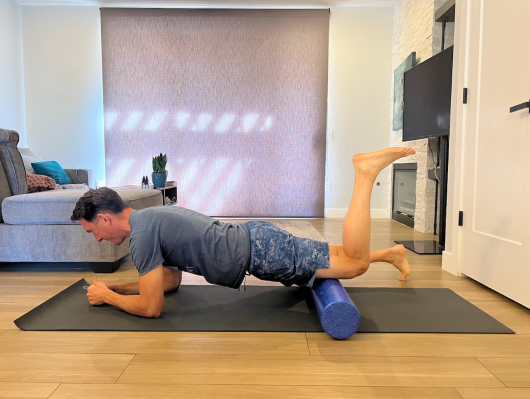
- Start facedown on your forearms with a foam roller positioned under the front of your right thigh. (More specifically, apply pressure to the rectus femoris, the large muscle located in the center of the quadriceps.) Allow your left leg to rest on the floor beside the foam roller.
- Roll and rock your quad over the foam roller until you land on a sensitive spot.
- Then, use your body weight to apply pressure. “The foam roller should be mild to moderately uncomfortable. You should not be tense or wincing in pain,” Wickham says.
- As you maintain pressure, maximally bend and straighten your right knee 3 to 4 times.
- Adjust the positioning of the roller by a millimeter or so to find a new tender spot. Again, bend and straighten your knee 3 to 4 times.
- Repeat for about 2 minutes, then switch legs.
2. Glute muscle and fascia release
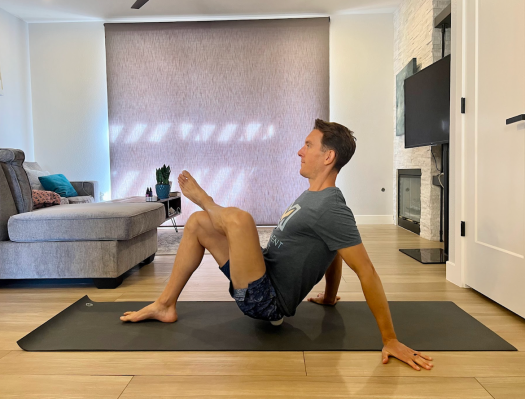
- Sit on the floor with your left ankle resting on your right knee. Place a mobility ball under your left glute.
- Using your hands and right leg to maintain balance and support your weight, roll your glute over the ball until you land on a sensitive spot.
- Pause, allowing the ball to sink into your muscle tissue and fascia. If it feels more effective, you can also gently rock back and forth over the tender area.
- Shift your position by a millimeter or so and stop when you hit another tight area. Again, pause and use your body weight to apply pressure to the sensitive spot.
- Repeat for about 2 minutes, then switch sides.
3. Active 90-90 stretch
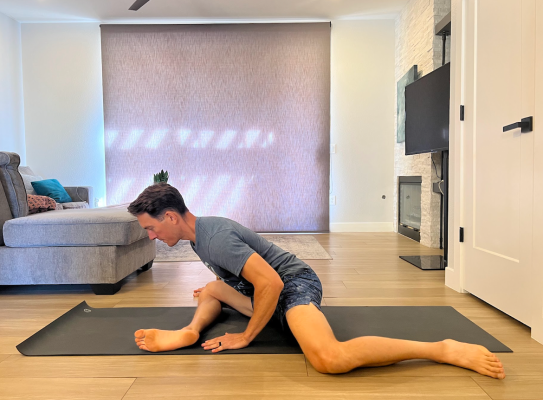
- Sit on the floor with your legs extended in front of you.
- Bend your right knee 90 degrees, externally rotate your hip, and rest your leg on the ground in front of you.
- Draw your left leg to the side and behind you, bending your knee 90 degrees so that the insides of your left thigh and calf are resting on the ground. Your right shin should be parallel to your left thigh.
- Lean forward until you feel a deep stretch in your right glutes and hip.
- Next, drive your right leg into the ground so that the right gluteal muscles contract. Hold for 10 seconds, then release the contraction.
- Holding the stretch, try to lift your left leg off the ground. (Even if it doesn’t move, keep trying to lift your leg so that the left gluteal muscles contract.) Hold for 10 seconds, then release the contraction.
- Repeat the sequence 2 times, then switch legs.
4. Active hamstring stretch
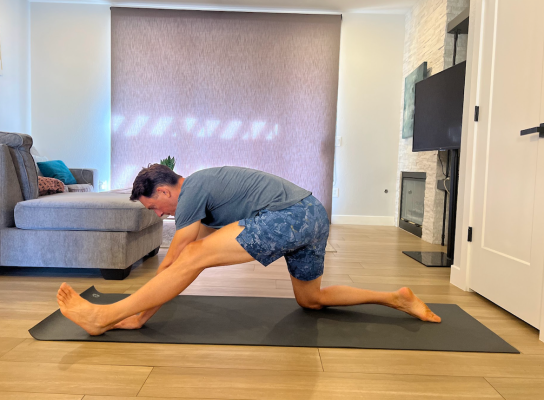
- Start in a low lunge position with your left leg in front, knee bent 90 degrees, and your right leg extended behind you, knee on the ground.
- Lean forward and place both palms on the ground inside your left foot.
- Extend your left leg and push your hips back until you feel a deep stretch in your left hamstring.
- Holding the stretch, contract your left hamstring by digging your left heel into the ground.
- Maintain the contraction for 20 seconds, then rest for 20 to 30 seconds.
- Repeat the 20-second contraction 2 more times, then switch legs.
5. Active adductor stretch
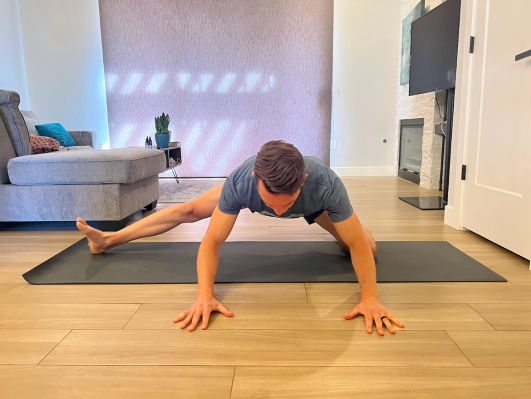
- Start on all fours with your knees wider than your hips.
- Extend your right leg out the the side and flex your foot so that your heel is on the ground and your toes are pointing up. Push your hips back until you feel a deep stretch in your inner right thigh.
- Drive your right heel into the ground. “This will cause your inner thigh adductor muscles to contract while they are maximally stretched out,” Wickham says.
- Hold the contraction for 20 seconds, then rest for 20 to 30 seconds.
- Repeat the 20-second contraction 2 more times, then switch legs.
6. Active hip flexor stretch
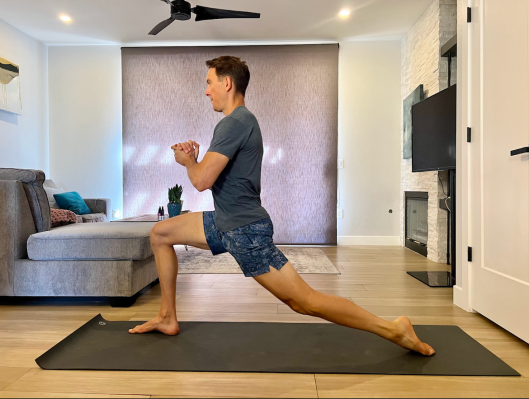
- Start in a low lunge position with your right leg in front, knee bent 90 degrees, and your left leg extended behind you, knee and top of the foot on the ground.
- Lean forward slightly (you should feel a stretch in your left quadriceps and hip flexors) and lift your left knee off the ground.
- Contract your left quadriceps as hard as possible by straightening your leg and driving the top of the foot into the floor.
- Hold the contraction for 10 seconds, then rest for 20 to 30 seconds.
- Perform 6 10-second contractions, then switch legs.
How to prevent tight hips once and for all
A regular mobility and active stretching practice can help keep you limber and prevent your hips from tightening up. Wickham recommends that everyone spend at least 10 minutes on active stretching three times a week. These sessions should include every major muscle group, including your hips.
“It’s a lot to get in with within 10 minutes,” Wickham says. So, people with tight hips may want to tack on a couple more hip-focused stretch sessions during which they spend all 10 minutes on the hips, glutes, hamstrings, and quads.
But keep in mind that 10 minutes won’t undo everything else you’re doing (or not doing) the other 23 hours and 50 minutes of the day.
“Stay active and avoid prolonged static positions,” Granat advises. “Take breaks from sitting and maintain good posture to avoid placing excessive strain on the hips.”
And whether you’re sitting, standing, or moving, add variety.
“Switch up your postures as much as you can throughout the day,” Wickham says. “If you’re sitting in a chair, vary the position of your legs. Cross one leg, cross the other leg, have both legs out,” he says. And if most of your workouts have you moving forward (think running, walking, and cycling), consider adding in some backward, side-to-side, and rotational movements.
FAQ
1. How long does it take to stretch tight hips?
As noted above, Wickham recommends spending at least 10 minutes on full-body stretching (including the hips) three times a week. If you have especially tight hips, add additional time to that baseline so you can focus on the hips.
2. Can walking release tight hips?
Yes, but walking alone isn’t enough, Granat says. “I always say, ‘Motion is lotion.’ Walking can help by promoting blood flow, improving joint mobility, and engaging the surrounding muscles,” she says. “However, it’s important to complement walking with specific hip-strengthening and stretching exercises.”
Source: Well and Good





